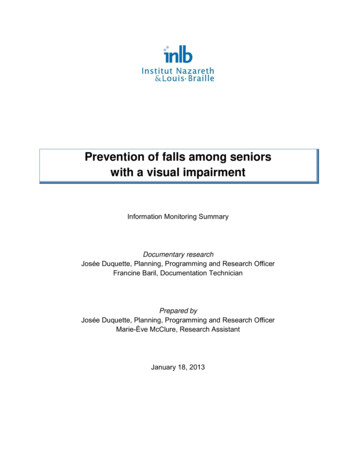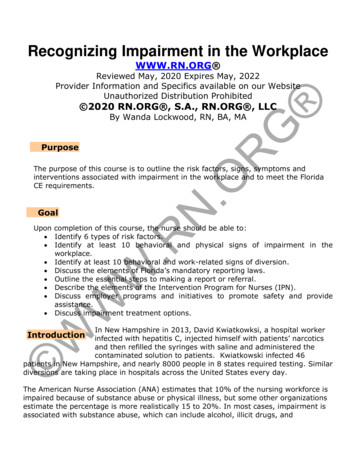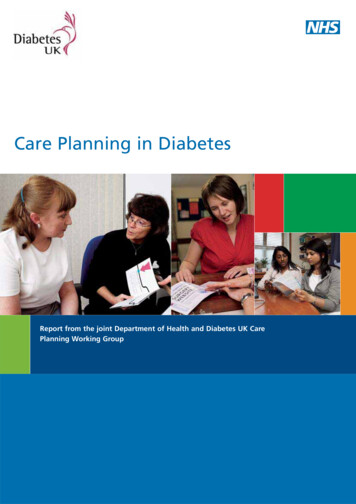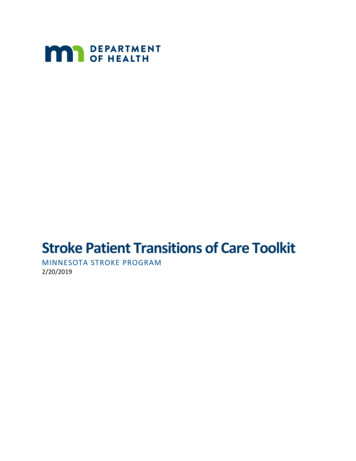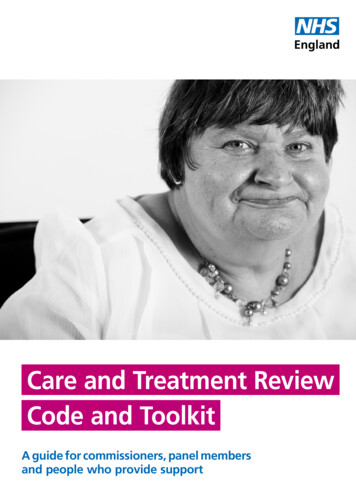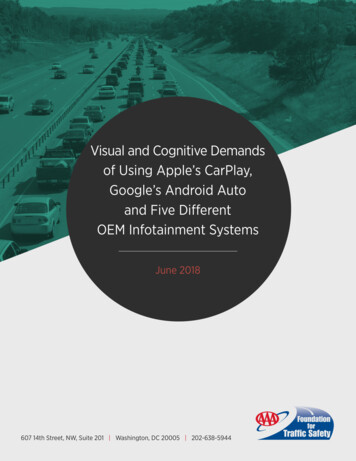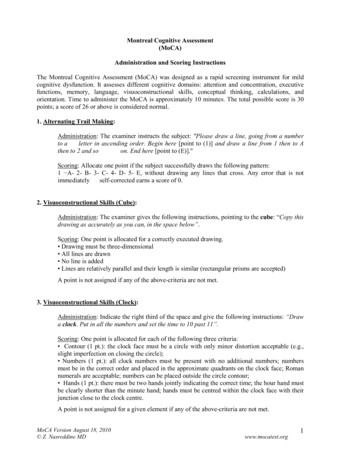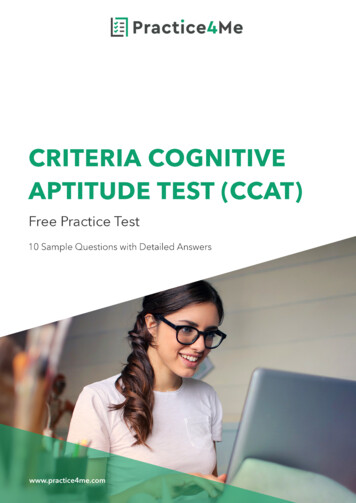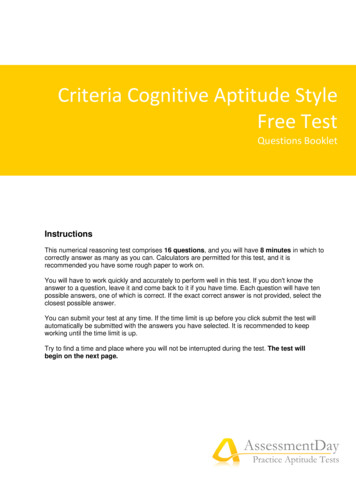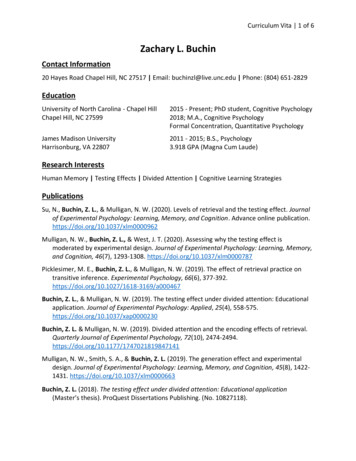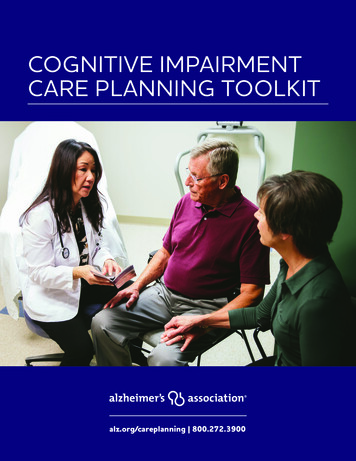
Transcription
COGNITIVE IMPAIRMENTCARE PLANNING TOOLKITalz.org/careplanning 800.272.3900
TABLE OF CONTENTSCognitive Assessment and Care Planning Services: Alzheimer’s AssociationExpert Task Force Recommendations and Tools for Implementation1Mini-Cog 8General Practitioner Assessment of Cognition (GPCOG) 10Montreal Cognitive Assessment (MoCA), short version 12Katz Index of Independence in Activities of Daily Living (ADL) 16Lawton-Brody Instrumental Activities of Daily Living Scale (IADL) 18Dementia Severity Rating Scale (DSRS) 20Decision Making Capacity Assessment 25The Neuropsychiatric Inventory Questionnaire (NPI-Q) 26BEHAV5 32Patient Health Questionnaire-2 (PHQ-2) 33Medication List for Review 34Safety Assessment Guide 35Caregiver Profile 42Single-Item Stress Thermometer 43End-of-Life Checklist 44Patient and Caregiver Resources 45alz.org/careplanning 800.272.3900
Cognitive Assessment and Care Planning Services:Alzheimer’s Association Expert Task Force Recommendations and Toolsfor Implementation11. Background and introduction to CPT code 99483The Alzheimer’s Association has long advocated for Medicare reimbursement for services aimed at improving detection,diagnosis, and care planning and coordination for patients with Alzheimer’s disease and related dementias (ADRD) and theircaregivers (Attea, Johns, 2010). These efforts, embodied in the Health Outcomes, Planning, and Education for Alzheimer’s(HOPE) Act and aided by support from physician groups involved in developing new Current Procedural Terminology (CPT)codes, culminated in approval of a Medicare procedure code, G0505, which took effect January 1, 2017. In January 2018,G0505 was replaced by CPT code 99483. Code 99483 provides reimbursement to physicians and other eligible billingpractitioners for a comprehensive clinical visit that results in a written care plan. Code 99483 requires an independenthistorian; a multidimensional assessment that includes cognition, function, and safety; evaluation of neuropsychiatric andbehavioral symptoms; review and reconciliation of medications; and assessment of the needs of the patient’s caregiver.(See the CPT 2018 manual for full details.) These components are central to informing, designing and delivering a careplan suitable for patients with cognitive impairment (Anonymous. Fed Register 2016).The Alzheimer’s Association Expert Task Force provided information and suggestions on the content and use of CodeG0505 (now 99483) to the Centers for Medicare & Medicaid (CMS) during the comment phase (Alzheimer’s AssociationTask Force, 2016), and reconvened in November 2016 to make recommendations about how to conduct the requiredassessments. Its recommendations derive from a broad consensus 1.about2 good clinical practice, informed by interventiontrials and emphasizing validated assessment tools that can be implemented in routine clinical care across the United States.The multidisciplinary task force was comprised of geographically dispersed experts in the United States who provideongoing clinical care for individuals with ADRD and/or have published recognized works in the field.2. Who is eligible to receive this comprehensive care planning service?Cognitive assessment and care plan services are provided when a comprehensive evaluation of a new or existing patient,who exhibits signs and/or symptoms of cognitive impairment, is required to establish or confirm a diagnosis, etiologyand severity for the condition.Do not report cognitive assessment and care plan services if any of the required elements are not performed or aredeemed unnecessary for the patient’s condition. For these services, see the appropriate evaluation and management(E/M) code. (American Medical Association, CPT 2018).3. Who can provide this service?Any practitioner eligible to report E/M services can provide this service. Eligible providers include physicians (MD and DO),nurse practitioners, clinical nurse specialists, and physician assistants. Eligible practitioners must provide documentationthat supports a moderate-to-high level of complexity in medical decision making, as defined by E/M guidelines (withapplication as appropriate of the usual “incident-to” rules, consistent with other E/M services) (Anonymous. Fed Register2016). The provider must also document the detailed care plan developed as a result of each required element coveredby 99483.Used with permission of the American Medical Association. (American Medical Association, 2018 Current ProceduralTerminology) Copyright American Medical Association (2018). All rights reserved.alz.org/careplanning 800.272.3900
4. What must the clinician do to meet the required elements for code 99483?Assessment of and care planning for a patient with cognitive impairment, requiring an independent historian, in the officeor other outpatient, home, domiciliary or rest home setting with all of the following required elements: Cognition-focused evaluation including a pertinent history and examination; Medical decision making of moderate or high complexity; Functional assessment (eg, basic and instrumental activities of daily living), including decision-making capacity; Use of standardized instruments for staging of dementia (eg, functional assessment staging test [FAST], clinicaldementia rating [CDR]); Medication reconciliation and review for high-risk medications; Evaluation for neuropsychiatric and behavioral symptoms, including depression, including use of standardizedscreening instrument(s); Evaluation of safety (eg, home), including motor vehicle operation; Identification of caregiver(s), caregiver knowledge, caregiver needs, social supports, and the willingnessof caregiver to take on caregiving tasks; Development, updating or revision, or review of an Advance Care Plan; Creation of a written care plan, including initial plans to address any neuropsychiatric symptoms, neurocognitivesymptoms, functional limitations, and referral to community resources as needed (eg, rehabilitation services,adult day programs, support groups) shared with the patient and/or caregiver with initial education and support.Typically, 50 minutes are spent face to face with the patient and/or family or caregiver.See the 2018 CPT manual for the full description and detailed instructions for code 99483.5. When, where and by whom can the required elements be assessed?1. 2The nine assessment elements of 99483 can be evaluated within the care planning visit or in one or more visitsthat precede it, using appropriate billing codes (most often an E/M code). Patients with complex medical, behavioral,psychosocial and/or caregiving needs may require a series of assessment visits, while those with well-defined or lesscomplex problems may be fully assessed during the care plan visit. Results of assessments conducted prior to the careplan visit are allowed in care planning documentation provided they remain valid or are updated with any changes atthe time of care planning.A single physician or other qualified health care professional should not report 99483 more than once every 180 days.Many of the required assessment elements can be completed by appropriately trained members of the clinical teamworking with the eligible provider. Assessments that require the direct participation of a knowledgeable care partneror caregiver, such as a structured assessment of the patient’s functioning at home or a caregiver stress measure, maybe completed prior to the clinical visit and provided to the clinician for inclusion in care planning. Care planning visitscan be conducted in the office or other outpatient, home, domiciliary or rest home settings.6. What measurement tools should be used to support the care planning process andits documentation?Standardized, validated tools are preferred whenever possible and are required for some elements (see Table 1 forsuggested tools). Such tools offer a basic framework on which to build a nuanced clinical understanding of care needsthrough ongoing clinical contact with the patient and caregiver. Though all required elements must be represented, thechoice of assessment tools should be customized for differing clinician styles and practice composition, workflows andoverall clinical goals. For example, primary care providers and dementia specialists may prefer different tools.alz.org/careplanning 800.272.39002
For several domains of care planning, simple, validated tools do not yet exist, and where they do, not all have beenformally tested for validity and uptake in actual primary care practices. In the table below, those that have been testedin primary care are marked with an asterisk; those untested in primary care have either high face validity (e.g., SafetyAssessment checklist) or published validation data that support further use. Ideally, tools should be: Practical: Time and effort to complete them fit the primary care clinical setting.Parsimonious: Provide enough information to support a meaningful care plan.Scorable: Results depicted in a single number.Retrievable: Easily incorporated into electronic health record fields and searchable at the point of care.Table 1: Suggested Measures to Support the Care-Planning ProcessThe table below provides examples of simpler and more complex tools acceptable for assessing each domain. In somesettings, a simple tool might be sufficient; in others, it could be used to trigger a more complex assessment or be replacedby a more detailed measure.DomainCognitionSuggested measuresMini-CogComments 3 min, validated in primary careGPCOGPatient/informant componentsShort MoCA 5 min, needs testing in primary careFunctionKatz (ADL), Lawton-Brody (IADL)Caregiver ratedStage of cognitive impairmentDementia Severity Rating ScaleCaregiver rated, correlates withClinical Dementia RatingDecision-making3-level rating: able to make own decisions, not able, uncertain/needs moreevaluationGlobal clinician judgmentNeuropsychiatric symptomsNPI-Q10 itemsDepressionBEHAVE 5 6 high-impact itemsPHQ-2Depression identificationMedication review and reconciliationMed list name of person overseeinghome medsIdentify/reconsider high-risk meds;assess for reliable administration byself or otherSafetySafety Assessment Guide7 questions (patient/caregiver)Caregiver identification andneeds assessmentCaregiver Profile ChecklistAbility/willingness to care, needs forinformation, education, and supportSingle-Item Stress ThermometerRapid identification of stressPHQ-2DepressionEnd-of-Life ChecklistScreen for preferences and legal needsAdvance care planning1. 3alz.org/careplanning 800.272.39003
7. The written care planPreparing the planThe care plan should reflect a synthesis of the information acquired as part of the assessment. It should be written inlanguage that is easily understood, indicate who has responsibility for carrying out each recommended action stepand specify an initial follow-up schedule.Some clinicians find it useful to organize the care plan into broad components, such as: Specific characteristics of the cognitive disorder (e.g., type and severity of cognitive impairment; special hazards suchas falls or orthostatic hypotension in Lewy body dementia; or referral to a dementia specialist for further diagnosticassessment or complex management). Management of any neuropsychiatric symptoms, including referrals for caregiver stress and behavior managementtraining or psychiatric care for the patient as indicated. Comorbid medical conditions and safety management, including any changes needed to accommodate the effectsof cognitive impairment. Caregiver stress and support needs, including primary care counseling and, as indicated, referrals to communitybased education and support, specialized individual or family counseling, or in-home care, legal or financial assistance.Documenting and sharing the planThough not required by 99483, a standardized care plan template customized to the provider or health care systemsimplifies communication and tracking of patient care and outcomes over time. The written plan must be discussedwith and given to the patient and and/or family or caregiver; this face-to-face conversation must be documented in theclinical note for all encounters reported using 99483. The care plan must be filed in the patient’s medical record whereit can be easily retrieved and updated. Sharing the plan with other providers caring for the patient, including clinicians,care managers, caseworkers, and others who assist the patient and caregiver, both within and outside the primary careenvironment will help ensure continuity and coordination of care. When1. 4 such sharing requires explicit consent of thepatient, family caregiver or legally designated decision-maker (DPOA holder), that permission should be sought anddocumented.8. How often can 99483 be used?Qualified health care professionals may report 99483 as frequently as once per 180 days, per CPT. However, payer policymay say otherwise and should be consulted. Care plans should be revised at intervals and whenever there is a change inthe patient’s clinical or caregiving status. Medicare intermediaries may audit the frequency of use.9. How does 99483 relate to Chronic Care Management (CPT 99490)?CPT code 99490 is an appropriate service to use for monthly care management of a patient with dementia plus at leastone other chronic condition, after a cognitive impairment care plan has been developed and documented.10. Identifying proper codingCPT code 99483 was developed to provide reimbursement for comprehensive evaluation of a new or existing patient,who exhibits signs and/or symptoms of cognitive impairment, is required to establish or confirm a diagnosis, etiology andseverity for the condition. This service includes a thorough evaluation of medical and psychosocial factors, potentiallycontributing to increa
Though not required by 99483, a standardized care plan template customized to the provider or health care system simplifies communication and tracking of patient care and outcomes over time. The written plan must be discussed with and given to the patient and and/or family or caregiver; this face-to-face conversation must be documented in theFile Size: 2MBPage Count: 47
